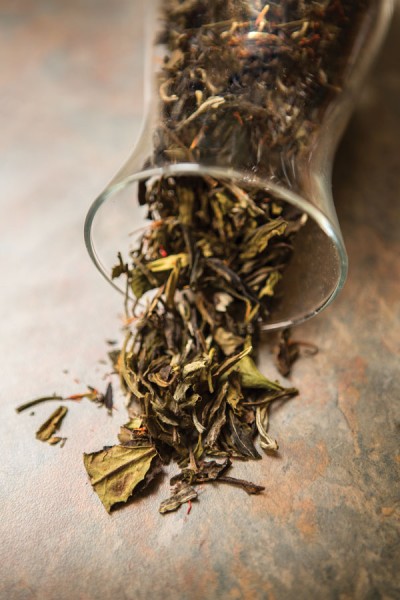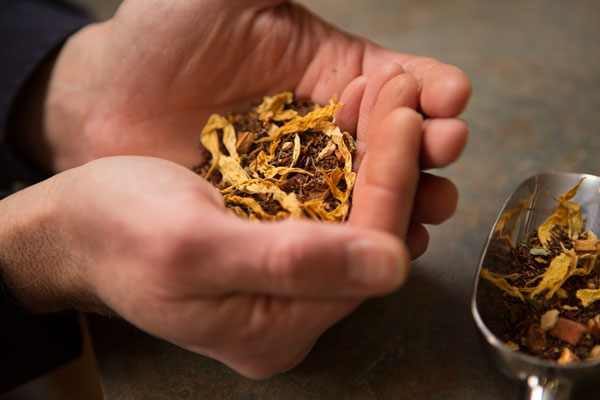Down on Howard Street, in between the many bars and restaurants that pepper the Old Market, the bright-green leaf decorated on the window of The Tea Smith can be easy to miss. But this deceptively simple store hosts the most impressive collection of tea in Omaha, and owner Tim Smith has received national and even international recognition for his treasured tea.
Now if this storefront had existed 20 or so years ago, Smith might have walked past it without batting an eye. “At that time I thought that tea was not much more than brown water and a bag, so I didn’t pay much attention to it,” says Smith. But a Valentine’s Day business trip changed his mind, after he picked up some loose leaf tea for his wife.
“When I got home, she [my wife] made me try it, and I said “oh this is good, this has got some character to it,’” says Smith. Some internet research led Smith to some a surprising fact about tea: that at the time, tea was the most consumed beverage in the world, but in the United States it was ranked sixth or seventh.
Smith began to see a possibility to expand the specialty tea market. If more of the high-quality loose leaf teas that he and his wife both loved were more widely available, tea might start to grow in popularity in the United States. While there weren’t many other established tea businesses to model themselves after, Smith decided to take a leap of faith, and opened The Tea Smith in December of 2004.
Smith’s concept behind The Tea Smith is “comfortable contemporary”—he wants anyone to be able to come into The Tea Smith and spend an hour or two relaxing with a nice cup of tea. This includes making the concept of tea more approachable to the average person, who might not know all about the complexities of tea.
Smith laughs when he recalls the early days of The Tea Smith, when “we’d tell someone we’d opened a tea store and they thought maybe t-shirts or something like that.” Now The Tea Smith plans a variety of educational programs, such as a “Tea 101 class” for beginners. Smith himself says that he is still always learning about tea—with over 10,000 different styles of tea that supposedly come from the same plant, Camellia sinensis, Smith hasn’t even come close to tasting them all.
This learning process has taken Smith to the source of his tea, to China, Japan, and Taiwan, and to tea expos all over the world. One of Smith’s highest recognitions came at the 2012 World Tea Expo in Las Vegas, when he was named “Top Tea Infusionist” after winning the expo’s Tea Infusionist Challenge. Smith, along with five other tea experts, was given six teas and had to prepare them on stage for a panel of judges. Participants were judged on their skill and handling of the tea, their ability to discuss the tea, and their success in implementing their desired flavors into their cup of tea.
It’s events like these that allow Smith and his staff to hone their teaching skills when it comes to the intricacies of different kinds of tea. The Tea Smith carries over 150 different kinds of tea, and it’s up to Smith and his employees—the “Tea Smithies”—to taste all of them and help customers find ones that will fit their palette.
Say a customer comes in and is completely new to tea. Smith and his employees will ask the customer what types of flavors he or she likes to help them find a tea that has those kinds of flavors in it. Smith will usually direct first-time tea consumers to something that’s not overly sweet or bitter, like a green tea. Looking for something a little bit more daring? Smith might direct you to one of their most popular drinks called South of the Border, a black tea with chocolate and chili pepper.rNathan Watson was also looking for something a little different when he stumbled upon the Tea Smith a year and a half ago. Born in the South, Watson’s been a tea drinker his whole life. But even he was blown away by all of the seemingly crazy tea concoctions The Tea Smith has.
“I can get Chai Tea at Scooter’s or I can get tea from Starbucks. They have two or three different kinds. Tea Smith has like 100,” says Watson.
Watson, a chief sales officer for Contemporary Analysis, has now become a regular at The Tea Smith. It’s his go-to place to meet with clients—he recalls with a laugh how he even hosted six or seven meetings back-to-back at The Tea Smith one day. Despite refilling his same teapot a dozen times throughout the day, Watson uncovered new flavors with each sip of tea. The robust flavors that came with the first brewing of his tea disappeared after the first couple of brewings, and were replaced by some of the subtle flavors that were originally unrecognizable.
“Tim taught me that trick. The second brewing, the third brewing, the fourth brewing all taste different,” says Watson.
It’s this combination of unmatchable knowledge about tea and wacky offerings that have made The Tea Smith such a hit. Out-of-town customers would often make the shop a regular spot on return trips to Omaha, and as many customers would buy bulk orders of a certain tea to take back home, Smith thought that he might be on to something. He decided to alter his original business plan to add a wholesale aspect to the mix. Now the store ships tea to customers all over the country, and even helps create tea menus for local restaurants such as Blue Sushi, The Grey Plume, Aroma’s, and Scooter’s Coffeehouse.
“As we got popular and we got the experience, we found that we were really able to help people that were starting into teas or help them improve the quality of the products that they’re offering,” says Smith.
It always comes back to this educational experience for Smith. With each new customer that comes into the store comes a new opportunity to expose another person to the beverage that he loves so much, and he hopes to continue to spread loose leaf tea around the country. Smith has plans to open more stores in the future outside of their Old Market and Tower Plaza locations, though he remains coy about them.
For now, Smith just remains excited about continuing to expand his knowledge of tea, pay it forward to his customers, and to expel misconceptions about the drink that he now considersr“more than just a beverage.”
“It [tea] is a part of culture, it’s a part of economics, it’s a part of history, as well as a part of health, so it’s absolutely fascinating,” says Smith, “and there’s always a lot to learn.”













